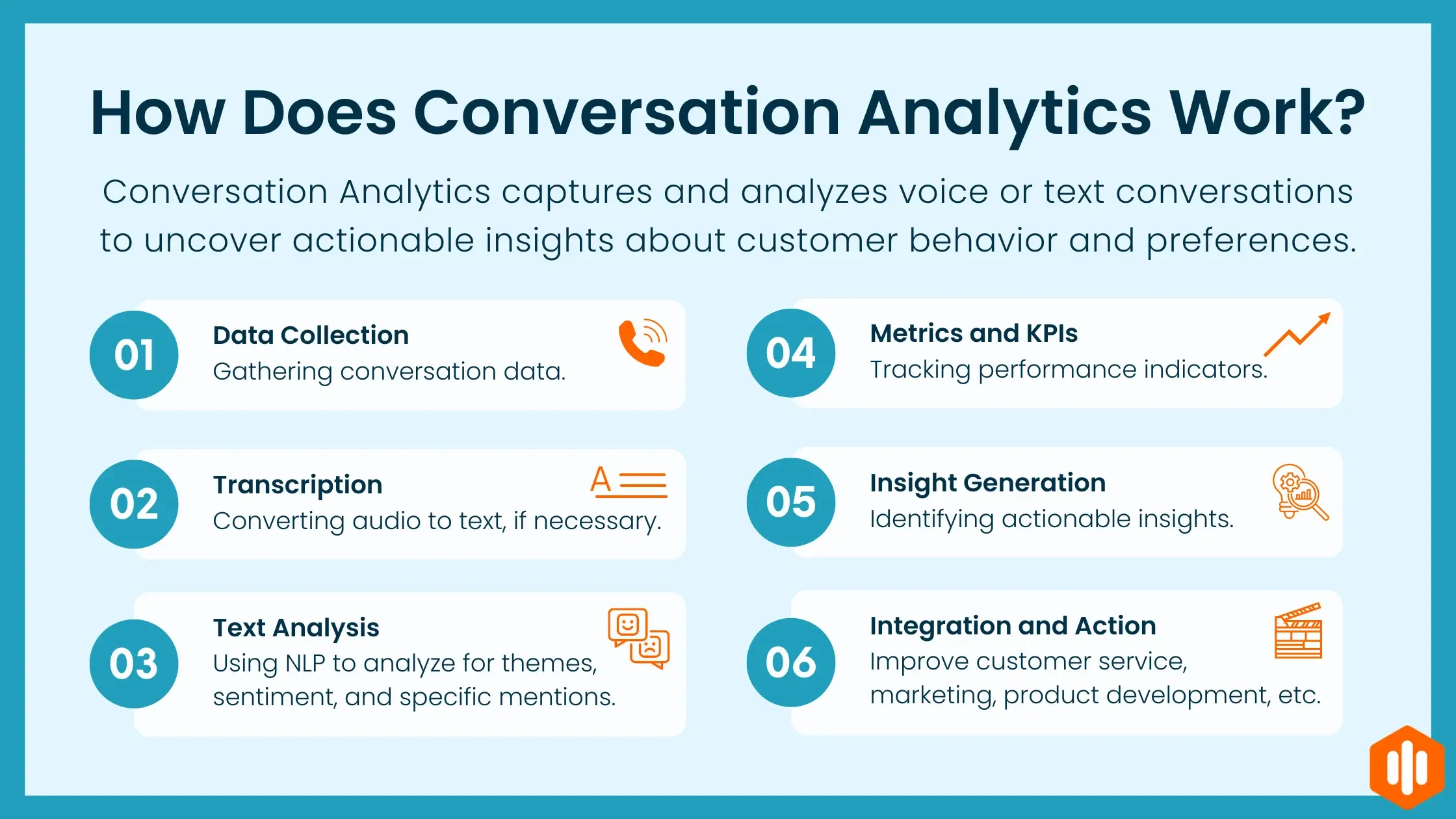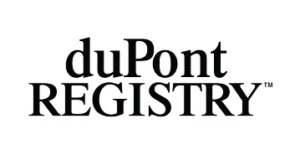
Conversation analytics is a sophisticated technology that analyzes spoken or written conversations between businesses and customers to extract valuable, actionable insights.
This technology leverages artificial intelligence (AI), particularly natural language processing (NLP), to understand, interpret, and derive meaningful information from the content, context, intent, sentiment, and other relevant aspects of communication.
Conversational Analytics seeks insights from customer interactions. It uses channels like phone calls, chatbots, emails, and social media. The goal is to enhance customer experience and service quality. It also aims to guide business decisions. Businesses gain valuable intelligence by examining conversation content, context, intent, and sentiment.
Understand Customer Needs and Preferences: Identify what customers are looking for, as well as their pain points, preferences, and expectations, to better cater to their needs.
Improve Customer Service: Analyze customer service interactions to discover areas of improvement, streamline processes, and enhance overall customer satisfaction.
Enhance Product and Service Offerings: Gather feedback on products and services directly from customer conversations to drive improvements innovations, and address gaps in the market.
Optimize Marketing and Sales Strategies: Use insights from customer interactions to refine marketing messages, identify sales opportunities, and tailor campaigns to match customer profiles and behaviors better.
Increase Operational Efficiency: Identify common issues and questions, automate responses to frequently asked questions, and improve response times, thereby reducing workload on human agents and increasing efficiency.
Drive Personalization: Personalize customer interactions based on their history, preferences, and behavior patterns identified through conversation analysis, enhancing the customer journey and loyalty.
Inform Strategic Decision Making: Provide business leaders with data-driven insights into customer trends, market needs, and operational effectiveness to guide strategic decisions.
Enhance Compliance and Risk Management: Monitor conversations for compliance with regulations and policies and use conversational analytics to detect fraud or other risks based on anomalies in conversation patterns.
Ultimately, Conversational Analytics aims to transform raw conversational data into a strategic asset that empowers businesses to create more engaging, effective, and personalized customer experiences, leading to improved customer loyalty, increased revenue, and competitive advantage.

The core elements of Conversational Analytics cover a wide array of technologies and methodologies. These are designed to interpret and analyze customer-business interactions using natural language. Combined, these elements transform unstructured data into actionable insights.
Natural Language Processing (NLP): NLP stands as a pivotal element. It enables computers to understand, interpret, and generate human language. NLP decodes textual content in this field, identifying phrases, topics, and dialogue structure.
Sentiment Analysis: This process detects the emotional tone in conversations. It helps businesses grasp customer feelings about their products, services, or brand. The emotions can be positive, negative, or neutral.
Intent Recognition: Identifying a customer’s intent is crucial. It allows businesses to categorize conversations and respond fittingly. Understanding the purpose behind words leads to more relevant responses.
Machine Learning and AI: These technologies are vital for handling vast conversational data. They learn from interactions, enhancing system accuracy. These tools adapt to new language patterns and trends.
Speech Recognition: Essential for voice interactions, this technology converts speech into text. NLP and other tools then analyze this text. It’s critical for phone calls and voice messages.
Topic and Keyword Extraction: This method finds main topics or keywords in conversations. It highlights common issues or interests, guiding businesses to focus on what matters to their audience.
Data Visualization and Reporting: Insights become visual reports and dashboards, making data accessible. Visualization tools clarify trends, patterns, and metrics.
Customer Journey Mapping: Conversation analysis across touchpoints sheds light on the customer journey. It identifies friction points and opportunities to enhance experience.
Personalization and Recommendations: Analyzing individual interactions enables businesses to tailor responses, offers, and recommendations. This boosts customer engagement and satisfaction.
Performance Monitoring: This ensures conversational interfaces and agents meet quality standards. It also highlights areas for improvement.
In sum, these components are the backbone of Conversational Analytics. They help businesses glean insights from customer conversations. This, in turn, can enhance customer experience, service delivery, product development, and overall strategy.

Customer Support Enhancement: By analyzing customer interactions, businesses can identify common issues, questions, and customer sentiments, allowing for the optimization of support strategies, automation of common queries, and improvement in overall customer satisfaction.
Sales and Marketing Optimization: Insights derived from conversational analytics can inform sales strategies by identifying customers’ interests, trends in customer inquiries, and potential upsell or cross-sell opportunities. In marketing, understanding the voice of the customer helps tailor campaigns that resonate better with the target audience.
Product and Service Feedback: Direct conversation feedback provides valuable insights into customer perceptions, likes, and dislikes regarding products and services, enabling companies to make data-driven improvements and innovations.
Personalization and Customer Engagement: Analyzing conversations helps businesses understand individual customer preferences and behaviors, allowing for personalized communication and offers, which enhance customer engagement and loyalty.
Operational Efficiency: Identifying frequently asked questions and common issues enables businesses to automate responses and streamline customer service processes, thereby increasing operational efficiency and reducing response times.
Compliance: Conversational analytics can monitor conversations for compliance with regulations and policies and detect fraudulent or suspicious behavior, thereby mitigating risks.
Implementing Conversational Analytics within an organization can significantly enhance customer interaction strategies, operational efficiency, and overall business intelligence. The benefits of adopting this advanced analytical approach are wide-ranging:
Enhanced Customer Experience and Satisfaction: By understanding customer needs, preferences, and sentiments in real-time, businesses can personalize interactions and respond more effectively to inquiries, complaints, or feedback, improving customer satisfaction and loyalty.
Increased Sales and Conversion Rates: Insights from conversational analytics can reveal customer intent, preferences, and buying signals, enabling targeted sales strategies and personalized offers that directly address the customer’s needs, thus increasing conversion rates and boosting revenue.
Improved Product and Service Development: Direct feedback and insights from customer conversations provide valuable data for product development teams, helping to identify unmet needs, areas for improvement, and opportunities for innovation, ensuring that new products or services are closely aligned with customer expectations.
Data-Driven Decision-Making: The rich, qualitative data provided by conversational analytics equips business leaders with actionable insights for strategic decision-making, from marketing and sales strategies to customer service improvements.
Competitive Advantage: Businesses that effectively leverage conversational analytics gain deeper insights into their customers than competitors who do not, offering a distinct competitive advantage in understanding and meeting customer needs.
Risk Mitigation: Conversational analytics can help identify compliance issues, potential fraud, and other risks in real-time conversations, allowing businesses to mitigate these risks immediately.
Marketing Effectiveness: Understanding the customer’s voice can inform more effective, targeted marketing campaigns and content strategies, ensuring messaging resonates with the intended audience and drives engagement.
Cost Savings: By optimizing customer service operations and increasing efficiency through automation and improved resource allocation, conversational analytics can lead to significant cost savings over time.
Improved Employee Performance and Training: Analysis of customer interactions can highlight areas where employees excel or need improvement, providing valuable data for personalized training programs and performance enhancement strategies.
Implementing conversational analytics transforms vast amounts of unstructured conversational data into a strategic asset, enabling businesses to innovate, improve customer experiences, and make informed decisions that drive success in today’s data-driven marketplace.
Conversational Analytics leverages AI and NLP to transform customer engagement. It analyzes interactions between businesses and customers. The goal is to extract actionable insights from human communication. This technology aims to improve customer experience and service quality. It also supports informed decision-making for businesses.
This approach interprets conversations’ content, context, intent, and sentiment. Businesses can thus identify customer needs and preferences. This leads to better customer service and direct feedback for product improvement. Marketing and sales strategies become more personalized and effective.
Operational efficiency sees major gains from Conversational Analytics. It automates responses and identifies common issues, saving resources. The technology also aids in compliance and risk management. It monitors conversations for regulatory adherence and potential fraud.
Implementing Conversational Analytics improves customer satisfaction and revenue opportunities. It informs product development and offers a competitive edge. This technology provides deep insights into customer behavior.
In conclusion, Conversational Analytics transforms conversational data into strategic insights. It enables engaging, personalized customer experiences. This improves loyalty and revenue, offering a competitive advantage through data-driven decisions.
It is a technology that analyzes conversations between businesses and customers. It uses AI and NLP to gain insights from communication.
AI and NLP play key roles. They interpret and extract information from customer-business conversations.
Its goal is to improve customer experience and service. Insights inform decisions, boosting loyalty and revenue.
It identifies needs, pain points, and preferences through conversation analysis. This enables more effective business responses.
It finds areas for service enhancement. Automating responses and improving response times are vital benefits.
Yes, by using feedback to drive product innovations and enhancements. It helps address market needs effectively.
It tailors marketing messages and identifies sales opportunities. Campaigns are refined to match customer profiles better.
Key elements include NLP, sentiment analysis, intent recognition, and machine learning. Also, AI, speech recognition, and data visualization are crucial.
Applications include enhancing customer support and optimizing sales. It also helps gather feedback and personalize engagement.
Benefits cover enhanced customer satisfaction and increased revenue. Also, it supports data-driven decisions and service quality improvements.

Book A Quick 15 Minute Call,
And We’ll Show You How To Unlock The Power Of Every Conversation.




























©2025 All rights reserved – Convirza